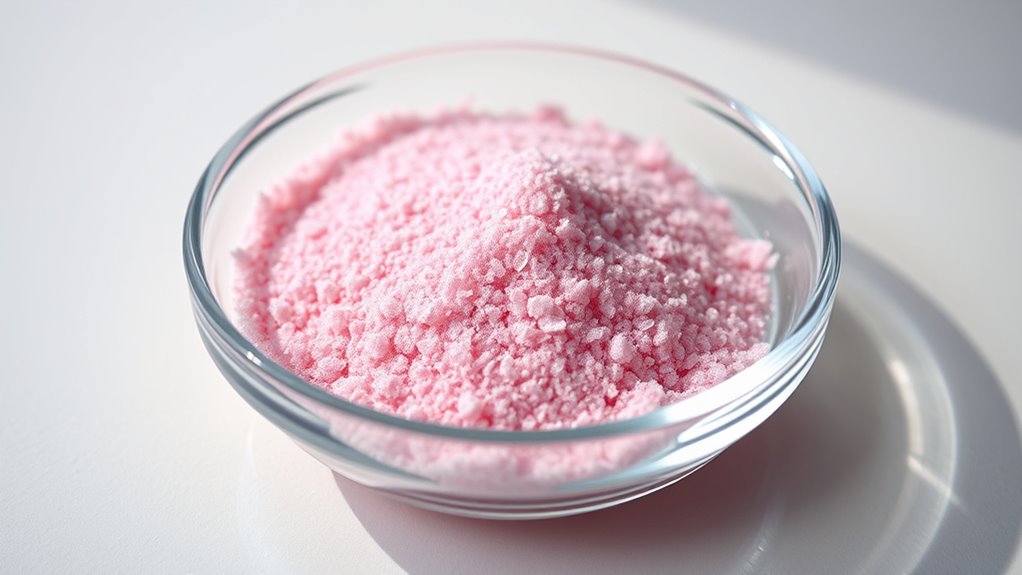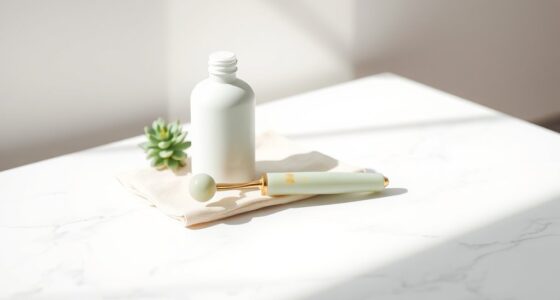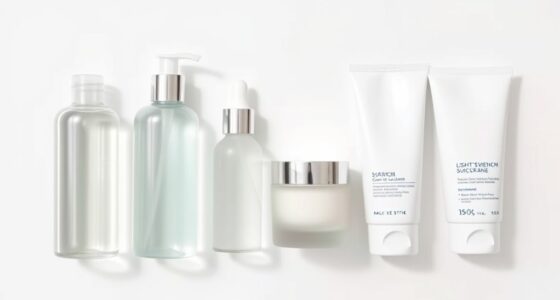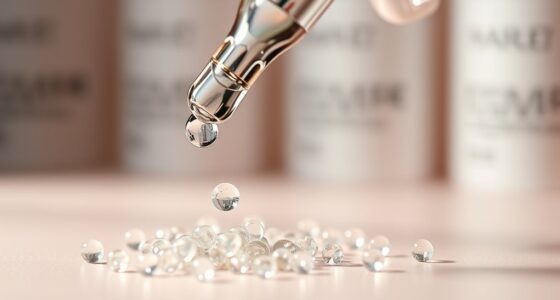Chemical exfoliation involves using acids like AHAs, BHAs, and PHAs to gently remove dead skin cells and improve your skin’s texture and brightness. AHAs are water-soluble and work on surface layers, while BHAs penetrate deeper into pores, making them good for acne-prone skin. PHAs are milder and suitable for sensitive skin. If you keep exploring, you’ll discover how to choose the right exfoliant for your skin type and needs.
Key Takeaways
- AHAs are water-soluble acids targeting surface dead skin for improved texture and brightness.
- BHAs are oil-soluble acids that penetrate deep into pores to treat acne and excess oil.
- PHAs are gentler, larger molecules suitable for sensitive or dry skin, offering mild exfoliation.
- Proper use of each acid type helps prevent over-exfoliation and skin irritation.
- Combining acids should be done cautiously to avoid disrupting the skin barrier.

Chemical exfoliation is a skincare technique that uses acids or enzymes to remove dead skin cells and reveal a brighter, smoother complexion. When you choose this method, you’re opting for a process that targets your skin’s surface in a precise way, often providing more even results than manual scrubs. Enzyme exfoliation is a popular form of chemical exfoliation that uses natural enzymes, like papain from papayas or bromelain from pineapples, to gently dissolve dead skin cells without harsh abrasion. Unlike physical exfoliants, which involve scrubbing your skin with gritty particles, enzyme exfoliation works on a biochemical level, breaking down the bonds holding dead cells together. This makes it especially suitable for sensitive skin, as it minimizes irritation and reduces the risk of microtears that can happen with physical scrubs.
Understanding the differences between physical and chemical exfoliation helps you choose what’s best for your skin type and concerns. Physical exfoliants involve manual scrubbing with particles like sugar, salt, or beads. While they can be effective at removing surface debris, they often cause microtears that may lead to irritation or inflammation over time. Chemical exfoliants like AHAs, BHAs, and PHAs, on the other hand, work by loosening the bonds between dead cells, allowing them to slough off naturally. AHAs (alpha hydroxy acids) are water-soluble and primarily target surface dead skin, improving brightness and texture. BHAs (beta hydroxy acids), like salicylic acid, penetrate deeper into pores, making them ideal for oily or acne-prone skin. PHAs (polyhydroxy acids) are gentler than AHAs and are suitable for sensitive or dry skin, providing exfoliation with less irritation.
When you incorporate chemical exfoliation into your routine, you’re leveraging these acids’ ability to enhance cell turnover and promote a healthier, more radiant complexion. Enzyme exfoliation offers a gentle alternative to acids, especially if your skin is sensitive or reactive. It’s important to note that both physical and chemical exfoliations have their place, but chemical options generally provide a more uniform and controlled exfoliation, reducing the chance of damaging your skin barrier. Whether you prefer enzyme exfoliation or acids like AHA, BHA, or PHA, understanding how they work helps you make smarter choices. Proper use, avoiding over-exfoliation, and choosing products suited for your skin type will ensure you get the benefits without irritation.
Frequently Asked Questions
Can Chemical Exfoliants Be Used Daily Safely?
You can use chemical exfoliants daily if your skin tolerates them well, but it’s vital to think about frequency safety. If you have sensitive skin or notice irritation, reduce usage to a few times a week. Always listen to your skin’s response and avoid over-exfoliating, which can increase sensitivity and cause redness. Use a gentle formula and follow up with sunscreen to protect your skin after exfoliation.
Are There Any Skin Types That Should Avoid AHAS, BHAS, or PHAS?
If you have sensitive or eczema-prone skin, you should be cautious with AHAs, BHAs, and PHAs. These exfoliants can cause irritation, redness, or worsen your condition. You might want to avoid daily use or opt for milder formulations. Always patch-test first, and consult a dermatologist to make certain these acids won’t trigger flare-ups or discomfort, helping you exfoliate safely without risking your skin’s health.
How Do I Choose the Right Exfoliant for My Skin?
To choose the right exfoliant, consider your skin sensitivity and ingredient compatibility. If your skin is sensitive, opt for PHA or lower concentrations of AHAs and BHA to minimize irritation. For oily or acne-prone skin, BHA works well for deep pore cleaning. Always patch-test new products and start with gentle formulas, gradually increasing strength as your skin adapts. This approach helps you find an effective exfoliant suited to your needs.
What Are the Signs of Over-Exfoliation or Irritation?
If you notice redness and peeling or feel a burning sensation after exfoliating, you’re likely overdoing it or irritating your skin. These signs indicate your skin’s barrier is compromised, and you should cut back on exfoliation. Pay attention to how your skin reacts and reduce frequency or strength of products. Always follow with soothing moisturizer and avoid harsh ingredients until your skin recovers.
Can Chemical Exfoliants Be Combined With Other Skincare Ingredients?
Imagine you’re layering an AHA with a vitamin C serum; it’s generally safe, but you should observe for ingredient interactions. You can combine chemical exfoliants with other skincare ingredients by using proper layering techniques, like applying lighter, water-based products first. Always patch test and avoid over-exfoliating. Combining ingredients thoughtfully ensures you maximize benefits while minimizing irritation and maintaining skin health.
Conclusion
Now that you know the basics of AHA, BHA, and PHA, you’ll be better equipped to choose the right exfoliant for your skin. Remember, incorporating chemical exfoliation can transform your skincare routine, revealing a brighter, smoother complexion. Are you ready to ditch dullness and embrace healthier skin? Just start slow, listen to your skin, and enjoy the glow that comes with consistent, informed care. Your radiant skin awaits—are you ready to take the first step?
Claire has a knack for turning complex dermatological concepts into engaging, easy-to-understand articles. Her work primarily focuses on creating detailed reviews and thought-provoking articles in the “Vetted” category. Claire’s writing not only informs but also inspires our community to try new skincare solutions.










